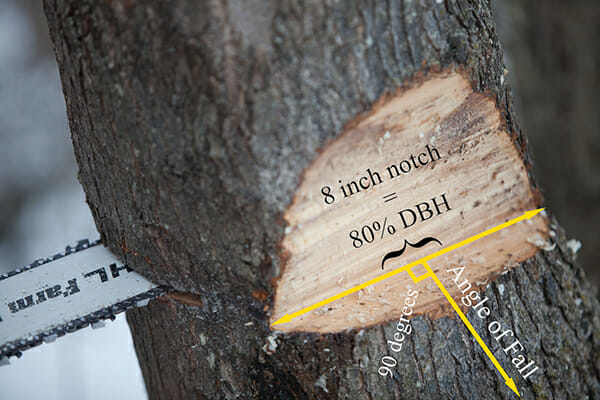1. Make sure you are wearing appropriate safety gear such as hearing protection, a face shield, gloves and protective chaps when felling the tree.
2. If possible, move to the side of the leaning tree opposite of its lean direction; this will make it easier to cut the tree in a controlled manner—towards its lean direction rather than away from it.
3. Clear any debris or obstacles surrounding the base of the trunk by at least two feet (0.6 meters).
4. Cut a shallow notch on both sides of the trunk towards which you want to direct its fall path with your chainsaw about one-third through its diameter and 45 degrees downward from horizontal; these cuts should meet in an inverted V shape at their bottom ends forming what is called a “face cut” or “felling cut” .
5 .Cut completely through on only one side—the side facing away from where you wish for it to fall; this is called an “undercut”.
- Clear the Area: Before you begin, make sure that the area is clear of any people or animals and there are no low-hanging branches or other obstacles that could pose a hazard while attempting to fell the tree
- Mark Your Cut: Carefully measure where your cut should be made, marking it clearly with chalk or spray paint so you can easily identify where to saw at once you have climbed up into position
- Secure Ropes: Attach ropes around the trunk of the tree above your mark and ensure they are securely fastened to nearby stationary trees or stakes in order to create tension as needed when cutting into one side of the trunk below your mark in order for it to fall in opposite direction desired (this will vary depending on if you’re trying to push over a leaning tree towards left/right)
- Climb & Position Chainsaw: One safely at height with chainsaw, line up blade carefully with marked cut location before beginning sawing process by making sure chain is engaged properly and all safety measures (ear protection) are employed prior to starting motorized tool’s engine
- Cut Into Trunk: Begin cutting from

Credit: modernfarmer.com
How Do You Cut a Leaning Tree the Opposite Direction?
If you’ve ever tried to cut down a tree that is leaning in the wrong direction, you know how difficult and dangerous it can be. The good news is that there are ways to safely cut a leaning tree in the opposite direction. In this blog post, we’ll explain how to do it step-by-step.
The first thing you should do before attempting any type of tree cutting is make sure your safety gear is on and all bystanders are at least 20 feet away from where you plan to work. Once everyone is out of harm’s way, use rope or straps to secure the top part of the trunk so it does not move while you’re cutting. This will ensure that no limbs swing into anyone as well as prevent any accidental injuries caused by falling branches and debris.
Next, use an axe or handsaw (whichever tool works best for your situation) to begin making cuts along one side of the trunk closest to ground level but above any major roots – usually about waist height or higher depending on how much lean the tree has.
How Do You Fell a Leaning Tree With a Chainsaw?
With proper training and safety precautions, you can fell a leaning tree with a chainsaw. This technique is tricky but doable if done correctly. Here’s what you need to know before attempting it:
Safety First Before using any power tool, be sure to wear the necessary protective gear, such as gloves, eyewear, hearing protection and chaps (or pants that cover your legs). It’s also important to have someone nearby in case of an emergency.
Make sure your chainsaw is well-maintained; sharpened blades will ensure a quicker and safer cut. Lastly, clear all obstacles from the area around the tree so that no one or nothing gets caught up in debris when it falls. Determine Direction of Fall
The first step is determining which direction the tree should fall. Look for natural signs like dead branches or rotten wood on one side of the trunk as this may indicate where it should go down safely without causing damage or injury along its path.
It’s important to pick a safe spot for its descent; away from homes and people yet close enough so you don’t have too much extra work cutting off excess limbs afterwards.
How Do You Make a Tree Fall Forward?
Making a tree fall forward is an important skill for anyone who works in the forestry industry, or plans to do some logging. It’s also an essential part of any arborist’s toolkit, as it can be used to safely remove trees from tight spaces without damaging property or people nearby. The process of making a tree fall forward is called “felling”, and there are several different techniques that can be used depending on the size and condition of the tree in question.
The most popular felling method involves using an axe or chainsaw to make two cuts—a notch on one side of the trunk, and a shallow cut on the opposite side slightly higher than the first cut. This creates what’s known as a hinge effect which will cause gravity to pull down on one side of the tree while pushing up against the other, allowing it to tip over into its intended direction when enough force has been applied.
To ensure accuracy and safety during felling operations, arborists should use established practices such as wedging (also known as back-cutting) and counterbalancing methods.
Cutting Down a Leaning Tree and Making It Fall In The Opposite Direction (How Not To) Ep 33
How to Fell a Leaning Tree Sideways
When looking at a leaning tree, the thought of felling it can be daunting. Felling a leaning tree sideways is not as hard as it looks and in fact, following the right steps increases safety for you and those around you. Here are some tips to help make this task easier:
1. Assess The Situation: Before starting any work on a falling tree, assess the situation carefully. Note whether or not there are obstacles nearby that could be impacted if the tree falls in an unexpected direction. Also look up and determine what type of trees surround your target so that you know where to stand while cutting it down.
2. Wear Protective Gear: Wearing protective gear such as goggles, long sleeves, gloves and boots is essential when felling trees especially ones that may have been damaged by storms or disease which can cause them to fall unpredictably or contain rotted wood inside them (which can splinter).
Conclusion
Felling a leaning tree with a chainsaw can be tricky, but it doesn’t have to be. With the right technique and safety precautions, you can fell a leaning tree in the opposite direction of its lean using your trusty chainsaw.
First, plan your cuts: make two notches facing away from the intended fall direction in order to control where the tree will fall.
The first cut should start at least halfway through the trunk, while the second is made parallel to it and slightly higher up. Then use wedges or other tools to open up this notch so that when you make your back cut (the third one) after taking off some bark around it on both sides for access, there’s room for your chain saw blade tip to enter safely without binding between them.
Next step is making sure you are safe!
Clear any debris away from where you’ll stand during the cutting process and wear appropriate safety gear such as goggles and ear protection.
Table of Contents

